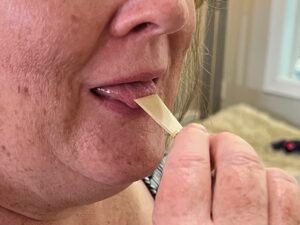Articulation is the term for the way you start a note, and it involves the front of the tongue. There are many types and styles of articulation and articulation plays an important role in creating musical moods and characters.
Your tongue should tap the front of the reed at the beginning of each note as you blow air into the reed. The picture below shows the point of contact between the tongue and the reed. Contact is not tip to tip but is just behind the tip of the tongue touching the front edge of the lower blade.

Every Articulation Has Two Parts
- Consonant (T or D and occasionally L)
- Air
To find the point where your tongue and the reed make contact (the consonant), do this exercise:
- Say the syllable “too” several times and notice what part of your tongue touches the ridge behind your top teeth. This part will touch the reed.
- Use the same quick flicking motion with your tongue, say “too” against the tip of the reed.
- The “t” comes from your tongue flicking against the reed.
- Your tongue will contact the lower blade of the reed just on the underside of the tip.
- The “oo” is the stream of air you release (blow) into the reed.
NOTE: Articulation without Air will not create sound so be sure you are blowing a steady stream of air into the reed as you articulate at the beginning of each note.
Choosing a Consonant
The consonant you use will change the sound of the articulation.
- “T” creates a clearly defined articulation that works well in all registers and dynamics mezzo forte and louder. “T” is created close to the tip of the tongue.
- “D” creates a less defined, less punctuated articulation that works well in the middle and upper registers and is especially helpful when playing in softer dynamics and for legato style. “D” can also work well in the lower register, but it takes the right kind of reed and a good bit of practice. “D” is created a little farther back on the tongue than “t”.
Establishing Good Articulation Technique
- The tongue should be relaxed, with the back generally low in the mouth and the tip resting lightly just behind the top of the bottom teeth.
- Begin every note with the tongue unless the music says otherwise.
- The tongue must touch the reed for proper articulation. Do not worry. You will not break the reed by tonguing on it.
- Lighter contact with the tongue will create a softer, lighter articulation and heavier/stronger contact with the tongue will create a heavier, more accented articulation.
- Rapid articulation requires the tongue to remain at the front of the mouth and only a small part of the tongue will move.
Teaching Tips
Because articulation happens inside of the mouth, it is impossible to see and easy to ignore. Faulty articulation is hard to fix once bad habits have developed.
- Listen: Notice how the notes begin. Do they begin immediately and seemingly without effort? Or are they delayed, loud, and uncontrolled?
- Talk: Make sure your students understand what they should be doing to articulate notes.
- Demonstrate: Model good articulation for your students. It will easier for them to replicate the sounds if they hear them.
- Discuss: Ask students to describe what they hear and what they feel is happening.

Feedback/Errata